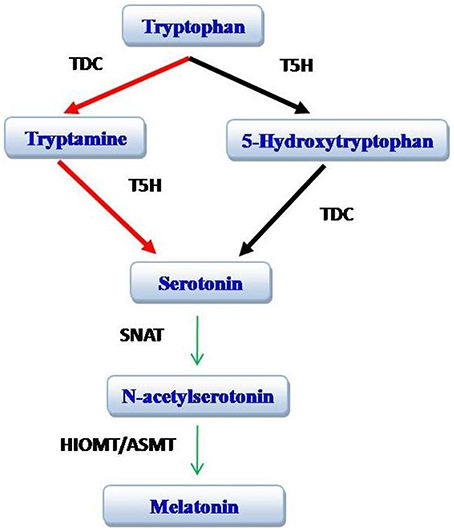
95% of researchers rate our articles as excellent or good
Learn more about the work of our research integrity team to safeguard the quality of each article we publish.
Find out more
CORRECTION article
Front. Plant Sci. , 24 May 2016
Sec. Plant Metabolism and Chemodiversity
Volume 7 - 2016 | https://doi.org/10.3389/fpls.2016.00714
This article is part of the Research Topic Melatonin in plants View all 26 articles
This article is a correction to:
Melatonin: Current Status and Future Perspectives in Plant Science
 Muhammad A. Nawaz1,2†
Muhammad A. Nawaz1,2† Yuan Huang1†
Yuan Huang1† Zhilong Bie1*
Zhilong Bie1* Waqar Ahmed3
Waqar Ahmed3 Russel J. Reiter4
Russel J. Reiter4 Mengliang Niu1
Mengliang Niu1 Saba Hameed1
Saba Hameed1A corrigendum on
Melatonin: Current Status and Future Perspectives in Plant Science
by Nawaz, M. A., Huang, Y., Bie, Z., Ahmed, W., Reiter, R. J., Niu, M., et al. (2016). Front. Plant Sci. 6:1230. doi: 10.3389/fpls.2015.01230
The readers are informed that the text given in the biosynthesis section of originally published article (doi: 10.3389/fpls.2015.01230) at line number 20–30 of page number two is not definitive and has very limited scientific evidence, so it should not be considered.
Some steps illustrated in originally published Figure 1, like the conversion of tryptamine to Indo-3-acetaldehyde and indole acetic acid (IAA), and direct conversion of serotonin to melatonin by SNAT are not definitive, as they have very limited scientific evidence. So these steps should not be considered the part of originally published Figure 1.

Figure 1. Biosynthesis of melatonin. The red arrows identify the preferred pathway in plants while the black arrows identify the major pathway in animals. TDC, tryptophan decarboxylase; T5H, tryptophan 5-hydroxylase; SNAT, serotonin N-acetyltransferase; HIOMT, hydroxyindole-O-methyltransferase [also known as acetyl serotonin methyl transferase (ASMT)]. Modified from Arnao and Hernandez-Ruiz (2014).
All authors listed, have made substantial, direct, and intellectual contribution to the work, and approved it for publication.
The authors declare that the research was conducted in the absence of any commercial or financial relationships that could be construed as a potential conflict of interest.
Keywords: melatonin, biosynthesis, physiological functions, antioxidants, root growth, stress tolerance
Citation: Nawaz MA, Huang Y, Bie Z, Ahmed W, Reiter RJ, Niu M and Hameed S (2016) Corrigendum: Melatonin: Current Status and Future Perspectives in Plant Science. Front. Plant Sci. 7:714. doi: 10.3389/fpls.2016.00714
Received: 22 April 2016; Accepted: 09 May 2016;
Published: 24 May 2016.
Edited and reviewed by: Haitao Shi, Hainan University, China
Copyright © 2016 Nawaz, Huang, Bie, Ahmed, Reiter, Niu and Hameed. This is an open-access article distributed under the terms of the Creative Commons Attribution License (CC BY). The use, distribution or reproduction in other forums is permitted, provided the original author(s) or licensor are credited and that the original publication in this journal is cited, in accordance with accepted academic practice. No use, distribution or reproduction is permitted which does not comply with these terms.
*Correspondence: Zhilong Bie, YmllemhpbG9uZ0Bob3RtYWlsLmNvbQ==
†These authors have contributed equally to this work.
Disclaimer: All claims expressed in this article are solely those of the authors and do not necessarily represent those of their affiliated organizations, or those of the publisher, the editors and the reviewers. Any product that may be evaluated in this article or claim that may be made by its manufacturer is not guaranteed or endorsed by the publisher.
Research integrity at Frontiers

Learn more about the work of our research integrity team to safeguard the quality of each article we publish.